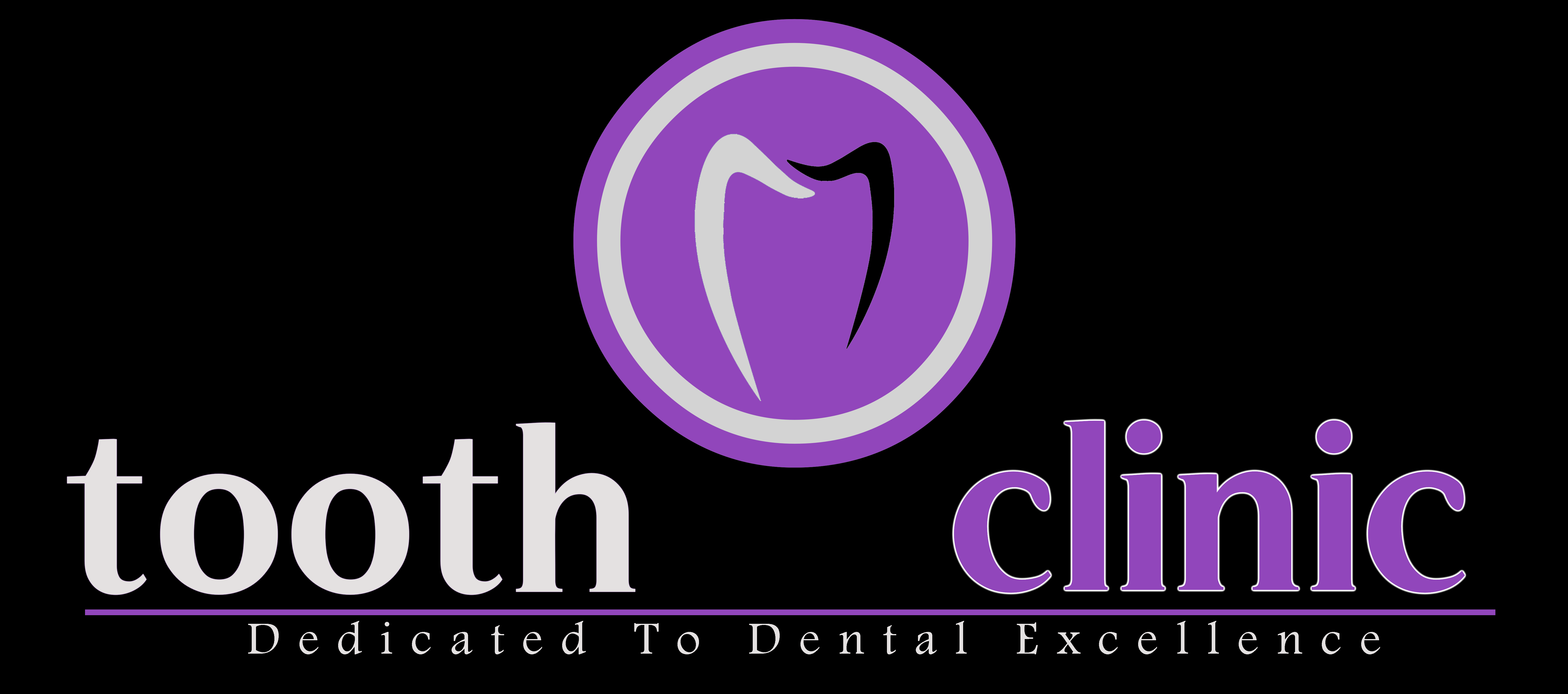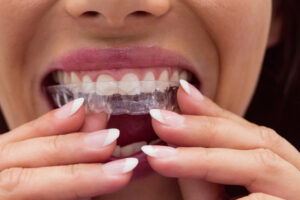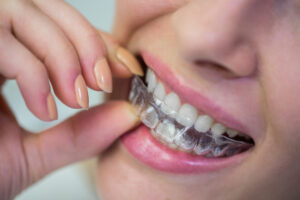Frequently Asked Questions
Several different options are available to change the shape of teeth, make teeth look longer, close spaces between teeth or repair chipped or cracked teeth. Among the options are bonding, crowns, veneers, and re-contouring.
Dental bonding is a procedure in which a tooth-coloured resin material (a durable plastic material) is applied to the tooth surface and hardened with a special light, which ultimately “bonds” the material to the tooth.Dental crowns are tooth-shaped “caps” that are placed over teeth. The crowns, when cemented into place, fully encase the entire visible portion of a tooth that lies at and above the gum line.Veneers (also sometimes called porcelain veneers or dental porcelain laminates) are wafer-thin, custom-made shells of tooth-coloured materials that are designed to cover the front surface of teeth. These shells are bonded to the front of the teeth. Re-contouring or reshaping of the teeth (also called odontoplasty, enameloplasty, stripping, or slenderizing) is a procedure in which small amounts of tooth enamel are removed to change a tooth’s length, shape or surface.
Each of these options differ with regard to cost, durability, “chair time” necessary to complete the procedure, stain resistant qualities, and best cosmetic approach to resolving a specific problem. Talk to us to see which one is right for you.
Looking great on your Wedding Day isn’t just about your hair & make-up. It’s also about increasing your face value.Today’s bride and groom want their guests to enjoy the wedding food but also want their guests to remember THEM. With all that you do to look your best why neglect your teeth, which is probably more important since you are all smiles on your Wedding Day. At TOOTH CLINIC we offer a wide range of services and treatments to give you that awesome look for your special day.
OUR PACKAGES
- Scaling (Cleaning) and Polishing
- Take Home Teeth Whitening
- Tooth Jewellery for an embellished smile
- Space Closure
- Smile Design
A dental implant is actually a replacement for the roots of a tooth. Like tooth roots, dental implants are secured in the jawbone and are not visible once surgically placed. They are used to secure crowns (the parts of teeth seen in the mouth), bridgework or dentures by a variety of means. They are made of titanium, which is lightweight, strong and bio-compatible, which means that it is not rejected by the body. Titanium and titanium alloys are the most widely used metals in both dental and other bone implants, such as orthopedic joint replacements. Dental implants have the highest success rate of any implanted surgical device.
Titanium’s special property of fusing to bone, called osseointegration (“osseo” – bone; “integration” – fusion or joining with), is the biological basis of dental implant success. That’s because when teeth are lost, the bone that supported those teeth is lost too. Placing dental implants stabilises bone, preventing its loss. Along with replacing lost teeth, implants help maintain the jawbone’s shape and density. This means they also support the facial skeleton and, indirectly, the soft tissue structures — gum tissues, cheeks and lips. Dental implants help you eat, chew, smile, talk and look completely natural. This functionality imparts social, psychological and physical well-being.
A dentist usually recommends braces to improve a patient’s “orofacial” appearance. Through orthodontic treatment, problems like crooked or crowded teeth,teeth with gaps, overbites or under-bites, incorrect jaw position and disorders of the jaw joints are corrected. If left untreated, these problems can result in tooth decay, gum disease, headaches and earaches, as well as speaking, biting or chewing problems.Well you also get that perfect ‘Million Dollar Smile’ everyone wants to have.
Patients with orthodontic problems can benefit from treatment at nearly any age. An ideal time for placement of braces is between 10 and 14 years of age, while the head and mouth are still growing and teeth are more accessible to straightening. However, treatment can be done till the age of 35 yrs,depending on the case.Braces aren’t just for kids. More and more adults are also wearing braces to correct minor problems and to improve their smiles.
Our orthodontist Dr Murtuza Agashiwala will know what appliance is best for your particular problem, but you often have a choice. Braces generally come in three varieties: The most popular type are brackets, metal, ceramic or plastic, that are bonded to teeth. Ceramic brackets are typically clear or tooth-coloured and are far less noticeable than metal brackets. Lingual or concealed braces are brackets that attach to the back of teeth, hidden from view. Both types of braces use wires to move the teeth to the desired position.
A new alternative to traditional braces is a series of clear, customised, removable appliances called aligners. Not only are these braces invisible, but they also are removable so they won’t trap food and plaque between your teeth like metal braces. You’ll wear each aligner for about two weeks and only remove it for eating, brushing and flossing. This may be an option for adults with mild spacing problems. Invisible aligners are not appropriate for children and adolescents who are still waiting for permanent teeth.
That depends upon your clinical condition and treatment plan. The more complicated your spacing or bite problem is, and the older you are, the longer the period of treatment, usually. Most patients can count on wearing full braces between 12 and 24 months, followed by the wearing of a retainer to set and align tissues surrounding straightened teeth.
This is a common procedure, designed to aid in the diagnosis of tooth and jaw problems. It’s a safe process that shouldn’t provide any discomfort or danger.X-rays are taken to help diagnose problems with teeth, gums, and the jaw. X-rays help our dentists see problems before they have a chance to develop and cause pain.They’re also easier to treat at this stage. Oral diseases often aren’t visible to the naked eye, so x-rays can be quite important for finding cavities, gum disease, oral infection and certain tumours.
Your teeth help you to break,bite and grind your food. Without them, you’re eating soft daal rice and khichadi for the rest of your life. If you pull a tooth out and don’t replace it , then the gum in that spot will no longer have support, or circulation, or protection to the bone and sinus cavity behind it. Teeth serve multiple functions; to chew, provide a guideline for the jaw placement, to protect the sinuses and bone structure of the jaw, and to exercise and provide blood circulation to the front half of the skull.
When you lose a tooth, the integrity of the structure is destroyed and you now have to make the tooth next to it, do the work of both teeth.The bone in the lost tooth space keeps on shrinking because its no longer functional. One tooth is not meant to do that much work for the rest of your life. You’ll eventually lose the other teeth on both sides of that empty space, whether it’s now, or 30 years from now.Not just that the teeth from the opposite jaw come out of the bone.
Here’s the rule of thumb: If a tooth CAN be saved, then it SHOULD be saved. With the exception of the wisdom teeth; and even with those – if they’re not causing any trouble or present a risk to the alignment of the jaw, then they should stay right where they are.
At TOOTH CLINIC we make use of an apex locator, rotary machine and rubber dam for doing a root canal treatment.
Apex locator is a machine that helps us to know the exact point where your tooth root ends.Yes they give an accuracy of 0.1mm. The old method of using an X ray to measure the root length had lot of drawbacks hence not used.
Rotary machines are used in combination with hand files to shape and clean the inside of the root surface (root canal).Rotary machine makes the filing and shaping more easy and fast hence patients experience the least amount of discomfort.The old method of using hand files would involve multiple sittings of long duration.With the help of an apex locator and rotary machine the root canal treatment can be completed even in a single sitting.
You must have seen doctors cover their patients with a clean green cloth before they do a surgery.That cloth is used to prevent contamination from other parts of the body (sweat,bacteria) to get into the surgical site.Similarly while doing a root canal a dentist uses a rubber dam.This prevents the oral bacteria from contaminating the root canal space while we clean and fill it.Thus ensuring you get the best treatment.
YES! By using FLUORIDE and tooth SEALANTS one can protect their teeth from getting cavities even BEFORE they start.ITS PAINLESS AND FAST.
Fluoride treatment is helpful to prevent decay in both children an d adults,anyone at risk of dental decay.Our teeth are made of what is called ‘hydroxyapatite’ crystals. When Fluoride is applied to the teeth it gets absorbed and the ‘hydroxyapatite’ gets converted to a ‘fluorapatite’ crysral. Fluorapatite is more resistant to acid attack by the bacteria.Fluoride not only protects the tooth but also remineralises the damages structure.
A sealant is a protective plastic coating, which is applied to the biting surfaces of the back teeth. It forms a hard shield that keeps food and bacteria from getting into the tiny grooves in the teeth and causing decay.
Sealants are only applied to teeth that have ‘pits’ (small hollows) and ‘fissures’ (grooves) on their biting surfaces. Our dentist at TOOTH CLINIC will tell you which teeth should be sealed after they have examined them, and checked whether the fissures are deep enough for sealing to help. Some teeth naturally have deep grooves which will need to be sealed; others have shallow ones which will not need sealing.
The process is quick and painless, taking only a few minutes for each tooth. The tooth is thoroughly cleaned, prepared with a special solution, and dried. The liquid sealant is then applied and allowed to set hard – usually by shining a bright light onto it.


